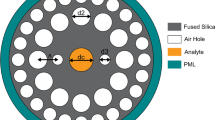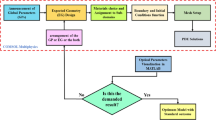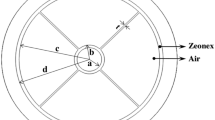Abstract
This article proposes a twin-core photonic crystal fiber (TC-PCF) with a hexagonal lattice that is designed to identify different cancers at an early stage using the refractive index of cancerous and normal cells in the terahertz (THz) frequency regime. The central elliptical hole of the TC-PCF, which is comparatively smaller than the rest of the air holes, is used in the proposed method to infiltrate liquid samples of cancer and normal cells at 80% and 30–70%, respectively. Subsequently, the model undergoes simulation across the frequency range of 0.7–0.8 THz in order to assess its optical characteristics. The finite element method (FEM) is used to evaluate the birefringence, transmission curve and coupling length of the TC-PCF to identify cancerous and normal cells. The transmitted spectral shift demonstrates that the proposed design provides a high optimal sensitivity of 1,016,666.67 nm/RIU, 1,521,428.57 nm/RIU, 1,578,571.42 nm/RIU, 1,370,000 nm/RIU, 1,671,428.57 nm/RIU and 1,507,142.85 nm/RIU for Hela, Jurkat, PC12, Basal, MDA-MB-231 and MCF-7 cancerous cells, respectively. These sensitivities are the highest that have been reported thus far, to the best of our knowledge. Additionally, the impact of changing air holes diameter on the proposed model's sensitivity is examined. Thus, the proposed TC-PCF sensor may be used to identify various kinds of cancer using this low-cost and simple detection technique.













Similar content being viewed by others
Availability of data and materials
Not applicable.
References
Ahmed, K., Ahmed, F., Roy, S., Paul, B.K., Aktar, M.N., Vigneswaran, D., Islam, M.S.: Refractive index-based blood components sensing in Terahertz Spectrum. IEEE Sens. J. 19, 3368–3375 (2019). https://doi.org/10.1109/JSEN.2019.2895166
Al Mahfuz, M., Mollah, M.A., Momota, M.R., Paul, A.K., Masud, A., Akter, S., Hasan, M.R.: Highly sensitive photonic crystal fiber plasmonic biosensor: design and analysis. Opt. Mater. (amst) 90, 315–321 (2019). https://doi.org/10.1016/j.optmat.2019.02.012
An, G., Li, S., An, Y., Wang, H., Zhang, X.: Glucose sensor realized with photonic crystal fiber-based Sagnac interferometer. Opt. Commun. 405, 143–146 (2017). https://doi.org/10.1016/j.optcom.2017.08.003
Arik, E., Koral, C., Altan, H., Esentürk, O.: A new method for alcohol content determination of fuel oils by terahertz spectroscopy.In: International Conference Infrared, Millimeter, Terahertz Waves, IRMMW-THz. (2013). https://doi.org/10.1109/IRMMW-THz.2013.6665885
Aslam Mollah, M., Yousufali, M., Faysal, M.R.B.A., Hasan, M.R., Hossain, M.B., Amiri, I.S.: Highly sensitive photonic crystal fiber salinity sensor based on Sagnac interferometer. Results Phys. (2020). https://doi.org/10.1016/j.rinp.2020.103022
Ayyanar, N., Thavasi Raja, G., Sharma, M., Sriram Kumar, D.: Photonic crystal fiber-based refractive index sensor for early detection of cancer. IEEE Sens. J. 18, 7093–7099 (2018). https://doi.org/10.1109/JSEN.2018.2854375
Bise, R.T., Trevor, D.J.: Sol-gel derived microstructured fiber: fabrication and characterization. In: Conference Optical Fiber Communications Techical Digest Series 3, 269–271 (2005). https://doi.org/10.1109/ofc.2005.192772
Bulbul, A.A.M., Imam, F., Awal, M.A., Mahmud, M.A.P.: A novel ultra-low loss rectangle-based porous-core pcf for efficient THz waveguidance: design and numerical analysis. Sensors (switzerland). 20, 1–18 (2020a). https://doi.org/10.3390/s20226500
Bulbul, A.A.M., Jibon, R.H., Das, S.K., Roy, T., Saha, A., Hossain, M.B.: PCF based formalin detection by exploring the optical properties in THz regime. Nanosci. Nanotechnol.-Asia. 11, 314–321 (2020b). https://doi.org/10.2174/2210681210999200525171303
Chaudhary, V., Singh, S.: Twin core photonic crystal fiber based temperature sensor with improved sensitivity over a wide range of temperature. Opt. Quant. Electron. (2023). https://doi.org/10.1007/s11082-022-04304-4
Cheon, H., Yang, H.J., Son, J.H.: Toward clinical cancer imaging using Terahertz spectroscopy. IEEE J. Sel. Top. Quant. Electron. (2017). https://doi.org/10.1109/JSTQE.2017.2704905
Clark, L.C.: Implantable gas-containing biosensor and method for measuring an analyte such as glucose. Biotechnol. Adv. 5, 343 (1987). https://doi.org/10.1016/0734-9750(87)90513-1
Cubillas, A.M., Unterkofler, S., Euser, T.G., Etzold, B.J.M., Jones, A.C., Sadler, P.J., Wasserscheid, P., Russell, P.S.J.: Photonic crystal fibres for chemical sensing and photochemistry. Chem. Soc. Rev. 42, 8629–8648 (2013). https://doi.org/10.1039/c3cs60128e
De, M., Pathak, A.K., Singh, V.K.: Single channel photonic crystal fiber based high sensitive petrol adulteration detection sensor. Optik (stuttg). 183, 539–546 (2019). https://doi.org/10.1016/j.ijleo.2019.03.001
Ebendorff-Heidepriem, H., Schuppich, J., Dowler, A., Lima-Marques, L., Monro, T.M.: 3D-printed extrusion dies: a versatile approach to optical material processing. Opt. Mater. Express 4, 1494 (2014). https://doi.org/10.1364/ome.4.001494
Eid, M.M.A., Rashed, A.N.Z., Bulbul, A.A.M., Podder, E.: Mono-rectangular core photonic crystal fiber (MRC-PCF) for skin and blood cancer detection. Plasmonics 16, 717–727 (2021). https://doi.org/10.1007/s11468-020-01334-0
Esfahani Monfared, Y.: Refractive index sensor based on surface plasmon resonance excitation in a D-shaped photonic crystal fiber coated by titanium nitride. Plasmonics 15, 535–542 (2020). https://doi.org/10.1007/s11468-019-01072-y
Fischer, B.M., Walther, M., Jepsen, P.U.: Far-infrared vibrational modes of DNA components studied by terahertz time-domain spectroscopy. Phys. Med. Biol. 47, 3807–3814 (2002). https://doi.org/10.1088/0031-9155/47/21/319
Fischer, B.M., Hoffmann, M., Helm, H., Wilk, R., Rutz, F., Kleine-Ostmann, T., Koch, M., Jepsen, P.U.: Terahertz time-domain spectroscopy and imaging of artificial RNA. Opt. Express 13, 5205–5215 (2005). https://doi.org/10.1364/opex.13.005205
Ghazanfari, A., Li, W., Leu, M.C., Hilmas, G.E.: A novel freeform extrusion fabrication process for producing solid ceramic components with uniform layered radiation drying. Addit. Manuf. 15, 102–112 (2017). https://doi.org/10.1016/j.addma.2017.04.001
Hajba, L., Guttman, A.: Circulating tumor-cell detection and capture using microfluidic devices. TrAC-Trends Anal. Chem. 59, 9–16 (2014). https://doi.org/10.1016/j.trac.2014.02.017
Huq Arif, M.F., Mobarak Hossain, M., Rahman, M.M., Mithun Kumar, P.K., Khaled, S.M.: Photonic crystal based liquid sensor: a theoretical analysis for formalin detection. In: 2018 Joint 7th International Conference Informatics, Electronics Vision. 2nd International Conference on Imaging, Vision Pattern Recognition, ICIEV-IVPR 2018. 295–299 (2019). https://doi.org/10.1109/ICIEV.2018.8640998
Iqbal, F., Biswas, S., Bulbul, A.A.M., Rahaman, H., Hossain, M.B., Rahaman, M.E., Awal, M.A.: Alcohol sensing and classification using PCF-based sensor. Sens. Bio-Sens. Res. 30, 100384 (2020). https://doi.org/10.1016/j.sbsr.2020.100384
Islam, M.S., Sultana, J., Ahmed, K., Islam, M.R., Dinovitser, A., Ng, B.W.H., Abbott, D.: A novel approach for spectroscopic chemical identification using photonic crystal fiber in the terahertz regime. IEEE Sens. J. 18, 575–582 (2018b). https://doi.org/10.1109/JSEN.2017.2775642
Islam, M.S., Faisal, M., Razzak, S.M.A.: Dispersion flattened extremely high-birefringent kagome lattice elliptic core photonic crystal fiber in THz regime. Opt. Quant. Electron. (2019a). https://doi.org/10.1007/s11082-019-1744-9
Islam, M.S., Sultana, J., Cordeiro, C.M.B., Cruz, A.L.S., DInovitser, A., Ng, B.W.H., Abbott, D.: Broadband characterization of glass and polymer materials using THz-TDS. In: International Conference on Infrared, Millimeter, Terahertz Waves, IRMMW-THz. 2019-Septe, (2019). https://doi.org/10.1109/IRMMW-THz.2019.8874013
Jabin, M.A., Ahmed, K., Rana, M.J., Paul, B.K., Islam, M., Vigneswaran, D., Uddin, M.S.: Surface plasmon resonance based titanium coated biosensor for cancer cell detection. IEEE Photon. J. (2019). https://doi.org/10.1109/JPHOT.2019.2924825
Jibon, R.H., Rahaman, M.E., Alahe, M.A.: Detection of primary chemical analytes in the THz regime with photonic crystal fiber. Sens. Bio-Sens. Res. 33, 100427 (2021). https://doi.org/10.1016/j.sbsr.2021.100427
Kanmani, R., Ahmed, K., Roy, S., Ahmed, F., Kumar Paul, B., Mani Rajan, M.S.: The performance of hosting and core materials for slotted core Q-PCF in Terahertz spectrum. Optik (stuttg). (2019). https://doi.org/10.1016/j.ijleo.2019.163084
Kaur, V., Singh, S.: Design approach of solid-core photonic crystal fiber sensor with sensing ring for blood component detection. J. Nanophotonics 13, 1 (2019). https://doi.org/10.1117/1.jnp.13.026011
Lataoui, J., Rjeb, A., Jaba, N., Fathallah, H., Machhout, M.: Design of elliptical photonic crystal fiber (E-PCF) for the transmission of 116 OAM channels across the S, C, L and U bands. Results Opt. 11, 100420 (2023). https://doi.org/10.1016/j.rio.2023.100420
Leon, M.J.B.M., Disha, A.S.: A simple structure of PCF based sensor for sensing sulfur dioxide gas with high sensitivity and better birefringence. Sens. Int. (2021). https://doi.org/10.1016/j.sintl.2021.100115
Li, T., Fan, Q., Liu, T., Zhu, X., Zhao, J., Li, G.: Detection of breast cancer cells specially and accurately by an electrochemical method. Biosens. Bioelectron. 25, 2686–2689 (2010). https://doi.org/10.1016/j.bios.2010.05.004
Li, F.R., Li, Q., Zhou, H.X., Qi, H., Deng, C.Y.: Detection of circulating tumor cells in breast cancer with a refined immunomagnetic nanoparticle enriched assay and nested-RT-PCR. Nanomed. Nanotechnol. Biol. Med. 9, 1106–1113 (2013). https://doi.org/10.1016/j.nano.2013.03.002
Markos, C., Stefani, A., Nielsen, K., Rasmussen, H.K., Yuan, W., Bang, O.: High-Tg TOPAS microstructured polymer optical fiber for fiber Bragg grating strain sensing at 110 degrees. Opt. Express 21, 4758–4765 (2013). https://doi.org/10.1364/OE.21.004758
Mishra, G.P., Kumar, D., Chaudhary, V.S., Murmu, G.: Cancer cell detection by a heart-shaped dual-core photonic crystal fiber sensor. Appl. Opt. 59, 10321 (2020). https://doi.org/10.1364/ao.409221
Mollah, M.A., Yousufali, M., Ankan, I.M., Rahman, M.M., Sarker, H., Chakrabarti, K.: Twin core photonic crystal fiber refractive index sensor for early detection of blood cancer. Sens. Bio-Sens. Res. 29, 100344 (2020). https://doi.org/10.1016/j.sbsr.2020.100344
Monfared, Y.E.: Overview of recent advances in the design of plasmonic fiber-optic biosensors. Biosensors (2020). https://doi.org/10.3390/BIOS10070077
Monfared, Y.E., Hajati, M., Liang, C., Yang, S., Qasymeh, M.: Quasi-D-shaped fiber optic plasmonic biosensor for high-index analyte detection. IEEE Sens. J. 21, 17–23 (2021). https://doi.org/10.1109/JSEN.2019.2945003
Mou, F.A., Rahman, M.M., Islam, M.R., Bhuiyan, M.I.H.: Development of a photonic crystal fiber for THz wave guidance and environmental pollutants detection. Sens. Bio-Sens. Res (2020). https://doi.org/10.1016/j.sbsr.2020.100346
Neugebauer, U., Clement, J.H., Bocklitz, T., Krafft, C., Popp, J.: Identification and differentiation of single cells from peripheral blood by Raman spectroscopic imaging. J. Biophoton. 3, 579–587 (2010). https://doi.org/10.1002/jbio.201000020
Paul, B.K., Ahmed, K.: Highly birefringent TOPAS based single mode photonic crystal fiber with ultra-low material loss for Terahertz applications. Opt. Fiber Technol. (2019). https://doi.org/10.1016/j.yofte.2019.102031
Paul, B.K., Islam, M.S., Ahmed, K., Asaduzzaman, S.: Alcohol sensing over O+E+S+C+L+U transmission band based on porous cored octagonal photonic crystal fiber. Photon. Sens. 7, 123–130 (2017). https://doi.org/10.1007/s13320-017-0376-6
Paul, B.K., Ahmed, K., Vigneswaran, D., Ahmed, F., Roy, S., Abbott, D.: Quasi-photonic crystal fiber-based spectroscopic chemical sensor in the terahertz spectrum: design and analysis. IEEE Sens. J. 18, 9948–9954 (2018). https://doi.org/10.1109/JSEN.2018.2872892
Paul, B.K., Ahmed, K., Vigneswaran, D., Sen, S., Islam, M.S.: Quasi photonic crystal fiber for chemical sensing purpose in the terahertz regime: design and analysis. Opt. Quant. Electron. 51, 1–12 (2019). https://doi.org/10.1007/s11082-019-1956-z
Paul, B.K., Ahmed, K., Dhasarathan, V., Nguyen, T.K.: Oligoporous-core Quasi cladding photonic crystal fiber based micro-sensor for alcohol detection. Phys. B Condens. Matter. (2020a). https://doi.org/10.1016/j.physb.2020.412104
Paul, B.K., Ahmed, K., El-Khozondar, H.J., Pobre, R.F., Peña, J.S.G., Merciales, M.C., Zainuddin, N.A.M., Zakaria, R., Dhasarathan, V.: The design and analysis of a dual-diamond-ring PCF-based sensor. J. Comput. Electron. 19, 1288–1294 (2020b). https://doi.org/10.1007/s10825-020-01509-2
Podder, E., Hossain, M.B., Jibon, R.H., Bulbul, A.A.M., Mondal, H.S.: Chemical sensing through photonic crystal fiber: sulfuric acid detection. Front. Optoelectron. 12, 372–381 (2019). https://doi.org/10.1007/s12200-019-0903-8
Poonam, S., Preeta, S.: Design of photonic crystal-based biosensor for detection of glucose concentration in urine. IEEE Sens. J. 15, 1035–1042 (2015). https://doi.org/10.1109/JSEN.2014.2359799
Rahaman, M.E., Saha, R., Ahsan, M.S., Sohn, I.B.: Design and performance analysis of a D-shaped PCF and surface plasmon resonance based glucose sensor. In: 4th International Conference on Electrical Engineering and Information and Commununication Technololgy. iCEEiCT 2018. 325–329 (2019). https://doi.org/10.1109/CEEICT.2018.8628080
Rahaman, M.E., Jibon, R.H., Mondal, H.S., Hossain, M.B., Bulbul, A.A.M., Saha, R.: Design and optimization of a PCF-based chemical sensor in THz regime. Sens. Bio-Sens. Res. 32, 100422 (2021). https://doi.org/10.1016/j.sbsr.2021.100422
Rahaman, M.E., Hossain, M.B., Mondal, H.S.: Effect of background materials in photonic crystal fiber sensor. Opt. Rev. 29, 1–6 (2022a). https://doi.org/10.1007/s10043-021-00712-1
Rahaman, M.E., Jibon, R.H., Ahsan, M.S., Ahmed, F., Sohn, I.B.: Glucose level measurement using photonic crystal fiber–based plasmonic sensor. Plasmonics 17, 1–11 (2022b). https://doi.org/10.1007/s11468-021-01497-4
Rahman, A., Rahman, A.K., Rao, B.: Early detection of skin cancer via terahertz spectral profiling and 3D imaging. Biosens. Bioelectron. 82, 64–70 (2016). https://doi.org/10.1016/j.bios.2016.03.051
Rahman, M.M., Mou, F.A., Al Mahmud, A., Bhuiyan, M.I.H., Islam, M.R.: Photonic Crystal Fiber based Terahertz Sensor for Alcohol Detection in Beverages: Design and Analysis. In: 3rd IEEE International Conference Telecommunication Photonics, ICTP 2019. (2019). https://doi.org/10.1109/ICTP48844.2019.9041767
Rahman, M.M., Mou, F.A., Bhuiyan, M.I.H., Islam, M.R.: Photonic crystal fiber based terahertz sensor for cholesterol detection in human blood and liquid foodstuffs. Sens. Bio-Sens. Res. (2020). https://doi.org/10.1016/j.sbsr.2020.100356
Ramanujam, N.R., Amiri, I.S., Taya, S.A., Olyaee, S., Udaiyakumar, R., Pasumpon Pandian, A., Joseph Wilson, K.S., Mahalakshmi, P., Yupapin, P.P.: Enhanced sensitivity of cancer cell using one dimensional nano composite material coated photonic crystal. Microsyst. Technol. 25, 189–196 (2019). https://doi.org/10.1007/s00542-018-3947-6
Ribaut, C., Loyez, M., Larrieu, J.C., Chevineau, S., Lambert, P., Remmelink, M., Wattiez, R., Caucheteur, C.: Cancer biomarker sensing using packaged plasmonic optical fiber gratings: towards in vivo diagnosis. Biosens. Bioelectron. 92, 449–456 (2017). https://doi.org/10.1016/j.bios.2016.10.081
Rifat, A.A., Mahdiraji, G.A., Sua, Y.M., Shee, Y.G., Ahmed, R., Chow, D.M., Adikan, F.R.M.: Surface plasmon resonance photonic crystal fiber biosensor: a practical sensing approach. IEEE Photon. Technol. Lett. 27, 1628–1631 (2015). https://doi.org/10.1109/LPT.2015.2432812
Roitberg, A., Heilweil, E.J., Markelz, A.G.: Pulsed terahertz spectroscopy of DNA, bovine serum albumin and collagen between 0.1 and 2.0 THz. Chem. Phys. Lett. 320, 42–48 (2000). https://doi.org/10.1016/S0009-2614(00)00227-X
Sarker, S., Vigneswaran, D., Studnička, F.: Design of a nanoscale gold-coated photonic crystal fiber biosensor. Front. Phys. (2023). https://doi.org/10.3389/fphy.2023.1164255
Shupeng Liu, S.L., Lianxin Li, L.L., Zhenyi Chen, Z.C., Na Chen, N.C., Zhangmin Dai, Z.D., Jing Huang, J.H., Bo Lu, B.L.: Surface-enhanced Raman spectroscopy measurement of cancerous cells with optical fiber sensor. Chin. Opt. Lett. 12, S13001-313003 (2014). https://doi.org/10.3788/col201412.s13001
Singh, S., Prajapati, Y.K.: Novel bottom-side polished PCF-based plasmonic biosensor for early detection of hazardous cancerous cells. IEEE Trans. Nanobiosci. (2023). https://doi.org/10.1109/tnb.2023.3233990
Soylemez, S., Udum, Y.A., Kesik, M., Gündoʇdu Hizliateş, C., Ergun, Y., Toppare, L.: Electrochemical and optical properties of a conducting polymer and its use in a novel biosensor for the detection of cholesterol. Sens. Actuators, B Chem. 212, 425–433 (2015). https://doi.org/10.1016/j.snb.2015.02.045
Sultana, J., Islam, M.S., Ahmed, K., Dinovitser, A., Ng, B.W.-H., Abbott, D.: Terahertz detection of alcohol using a photonic crystal fiber sensor. Appl. Opt. 57, 2426 (2018). https://doi.org/10.1364/ao.57.002426
Sun, D., Guo, T., Ran, Y., Huang, Y., Guan, B.O.: In-situ DNA hybridization detection with a reflective microfiber grating biosensor. Biosens. Bioelectron. 61, 541–546 (2014). https://doi.org/10.1016/j.bios.2014.05.065
Topas advanced polymer. [online]. available: https://topas.com/markets/electronics/more-electronics-apps. Accessed 15 Mar 2021
Vigneswaran, D., Ayyanar, N., Sharma, M., Sumathi, M., Mani, M.R., Porsezian, K.: Salinity sensor using photonic crystal fiber. Sens. Actuators, A Phys. 269, 22–28 (2018). https://doi.org/10.1016/j.sna.2017.10.052
World health organization, Cancer: https://www.who.int/news-room/fact-sheets/ detail/cancer, (2018).
Yasli, A.: Cancer detection with surface plasmon resonance-based photonic crystal fiber biosensor. Plasmonics 16, 1605–1612 (2021). https://doi.org/10.1007/s11468-021-01425-6
Yu, C., Fan, S., Sun, Y., Pickwell-Macpherson, E.: The potential of terahertz imaging for cancer diagnosis: a review of investigations to date. Quant. Imaging Med. Surg. 2, 33–45 (2012). https://doi.org/10.3978/j.issn.2223-4292.2012.01.04
Acknowledgements
The authors are grateful to the participants who contributed to this research. The authors have not received any funding for this research.
Funding
The authors have not received any funding for this research.
Author information
Authors and Affiliations
Contributions
VC: Methodology, Writing—review & editing. SS: Supervision, Writing—original draft, review & editing.
Corresponding author
Ethics declarations
Conflict of interest
The authors declare that they have no known competing financial interests or personal ties that would have influenced the work presented in this study.
Consent for publication
All authors provide consent for publication.
Consent to participate (Ethics)
All author is agreed to submit the paper in this journal.
Human and animal rights
No bad Impact on animal.
Additional information
Publisher's Note
Springer Nature remains neutral with regard to jurisdictional claims in published maps and institutional affiliations.
Rights and permissions
Springer Nature or its licensor (e.g. a society or other partner) holds exclusive rights to this article under a publishing agreement with the author(s) or other rightsholder(s); author self-archiving of the accepted manuscript version of this article is solely governed by the terms of such publishing agreement and applicable law.
About this article
Cite this article
Chaudhary, V., Singh, S. Highly sensitive twin core photonic crystal fiber for hazardous cancer cell detection in THz frequency regime. Opt Quant Electron 55, 1174 (2023). https://doi.org/10.1007/s11082-023-05462-9
Received:
Accepted:
Published:
DOI: https://doi.org/10.1007/s11082-023-05462-9




